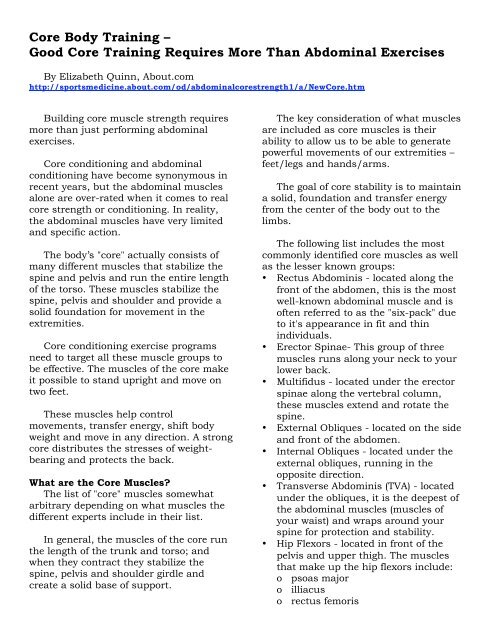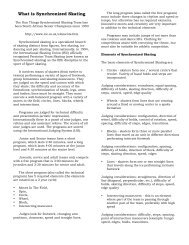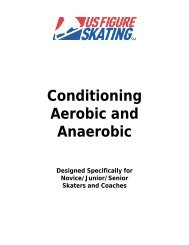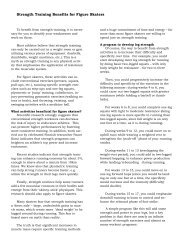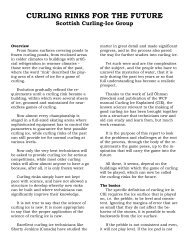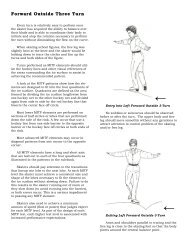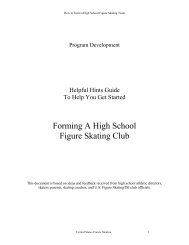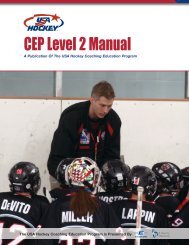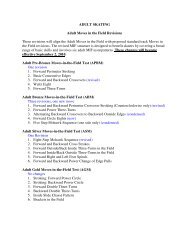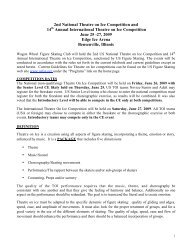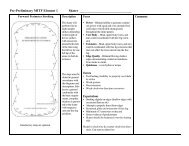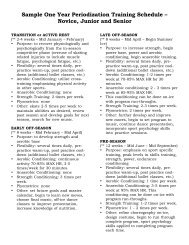Core Body Training - Ice skating resources
Core Body Training - Ice skating resources
Core Body Training - Ice skating resources
Create successful ePaper yourself
Turn your PDF publications into a flip-book with our unique Google optimized e-Paper software.
<strong>Core</strong> <strong>Body</strong> <strong>Training</strong> –<br />
Good <strong>Core</strong> <strong>Training</strong> Requires More Than Abdominal Exercises<br />
By Elizabeth Quinn, About.com<br />
http://sportsmedicine.about.com/od/abdominalcorestrength1/a/New<strong>Core</strong>.htm<br />
Building core muscle strength requires<br />
more than just performing abdominal<br />
exercises.<br />
<strong>Core</strong> conditioning and abdominal<br />
conditioning have become synonymous in<br />
recent years, but the abdominal muscles<br />
alone are over-rated when it comes to real<br />
core strength or conditioning. In reality,<br />
the abdominal muscles have very limited<br />
and specific action.<br />
The body’s "core" actually consists of<br />
many different muscles that stabilize the<br />
spine and pelvis and run the entire length<br />
of the torso. These muscles stabilize the<br />
spine, pelvis and shoulder and provide a<br />
solid foundation for movement in the<br />
extremities.<br />
<strong>Core</strong> conditioning exercise programs<br />
need to target all these muscle groups to<br />
be effective. The muscles of the core make<br />
it possible to stand upright and move on<br />
two feet.<br />
These muscles help control<br />
movements, transfer energy, shift body<br />
weight and move in any direction. A strong<br />
core distributes the stresses of weightbearing<br />
and protects the back.<br />
What are the <strong>Core</strong> Muscles?<br />
The list of "core" muscles somewhat<br />
arbitrary depending on what muscles the<br />
different experts include in their list.<br />
In general, the muscles of the core run<br />
the length of the trunk and torso; and<br />
when they contract they stabilize the<br />
spine, pelvis and shoulder girdle and<br />
create a solid base of support.<br />
The key consideration of what muscles<br />
are included as core muscles is their<br />
ability to allow us to be able to generate<br />
powerful movements of our extremities –<br />
feet/legs and hands/arms.<br />
The goal of core stability is to maintain<br />
a solid, foundation and transfer energy<br />
from the center of the body out to the<br />
limbs.<br />
The following list includes the most<br />
commonly identified core muscles as well<br />
as the lesser known groups:<br />
• Rectus Abdominis - located along the<br />
front of the abdomen, this is the most<br />
well-known abdominal muscle and is<br />
often referred to as the "six-pack" due<br />
to it's appearance in fit and thin<br />
individuals.<br />
• Erector Spinae- This group of three<br />
muscles runs along your neck to your<br />
lower back.<br />
• Multifidus - located under the erector<br />
spinae along the vertebral column,<br />
these muscles extend and rotate the<br />
spine.<br />
• External Obliques - located on the side<br />
and front of the abdomen.<br />
• Internal Obliques - located under the<br />
external obliques, running in the<br />
opposite direction.<br />
• Transverse Abdominis (TVA) - located<br />
under the obliques, it is the deepest of<br />
the abdominal muscles (muscles of<br />
your waist) and wraps around your<br />
spine for protection and stability.<br />
• Hip Flexors - located in front of the<br />
pelvis and upper thigh. The muscles<br />
that make up the hip flexors include:<br />
o psoas major<br />
o illiacus<br />
o rectus femoris
o pectineus<br />
o sartorius<br />
• Gluteus medius and minimus - located<br />
at the side of the hip<br />
• Gluteus maximus, hamstring group,<br />
piriformis - located in the back of the<br />
hip and upper thigh leg.<br />
• Hip adductors - located at medial<br />
thigh.<br />
Strengthening the <strong>Core</strong> Reduces Back<br />
Pain<br />
Abdominals get all the credit for<br />
protecting the back and being the<br />
foundation of strength, but they are only a<br />
small part of what makes up the core. In<br />
fact, it is weak and unbalanced core<br />
muscles that are linked to low back pain.<br />
Weak core muscles result in a loss of<br />
the appropriate lumbar curve and a<br />
swayback posture. Stronger, balanced<br />
core muscles help maintain appropriate<br />
posture and reduce strain on the spine.<br />
<strong>Core</strong> Strength <strong>Training</strong> and Athletic<br />
Performance<br />
Because the muscles of the trunk and<br />
torso stabilize the spine from the pelvis to<br />
the neck and shoulder, they allow the<br />
transfer of powerful movements of the<br />
arms and legs.<br />
All powerful movements originate from<br />
the center of the body out, and never from<br />
the limbs alone. Before any powerful,<br />
rapid muscle contractions can occur in<br />
the limbs, the spine must be solid and<br />
stable and the more stable the core, the<br />
most powerful the extremities can<br />
contract.<br />
<strong>Training</strong> the muscles of the core also<br />
corrects postural imbalances that can lead<br />
to injuries. The biggest benefit of core<br />
training is to develop functional fitness -<br />
that is, fitness that is essential to both<br />
daily living and regular activities.<br />
<strong>Core</strong> strengthening exercises are most<br />
effective when the torso works as a solid<br />
unit and both front and back muscles<br />
contract at the same time, multi joint<br />
movements are performed and<br />
stabilization of the spine is monitored.<br />
Strengthening the <strong>Core</strong> Muscles<br />
There are many exercises that will<br />
strengthen the core, as well as exercise<br />
equipment that will aid this training.<br />
Some of the best products for developing<br />
core strength include:<br />
• Medicine Balls<br />
• Kettlebells<br />
• Stability Balls<br />
• Balance Products – i.e. Bosu Ball,<br />
balance boards, wobble boards, etc.<br />
• Dumbbells<br />
No Equipment <strong>Core</strong> Strength Exercises<br />
<strong>Body</strong> weight exercises are very effective<br />
for developing core strength. They are also<br />
the type of exercises many athletes and<br />
coaches rely on for regular core training.<br />
They include:<br />
Abdominal Bracing<br />
This is the main technique used during<br />
core exercise training. It refers to the<br />
contraction of the of the abdominal<br />
muscles.<br />
To correctly brace, you should attempt<br />
to pull your navel back in toward your<br />
spine. This action primarily recruits<br />
transverse abdominus.<br />
You should be able to breathe evenly<br />
while bracing. Be careful not to hold your<br />
breath while performing the following<br />
exercises:<br />
• Plank Exercise: Start Position | Finish<br />
Position<br />
• Side Plank Exercise: Start Position |<br />
Finish Position<br />
• The Basic Push Up<br />
• V-sits<br />
• Push Ups<br />
• Squats
• Back Bridge<br />
• Hip Lift<br />
• Russian Twists<br />
• Lunges<br />
• Side Lunges<br />
• Back Extensions<br />
Other exercises that develop core<br />
strength include exercises on a stability<br />
ball, work with medicine balls, wobble<br />
boards, and Pilate's exercise programs.<br />
Yoga is also an excellent way for athletes<br />
to build core strength.<br />
For a simple core strength program you<br />
can begin with push-ups and crunches,<br />
but work with a trainer to find the<br />
exercises that work best for you.


